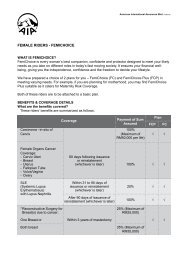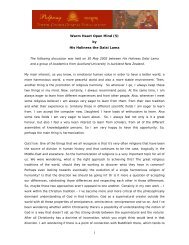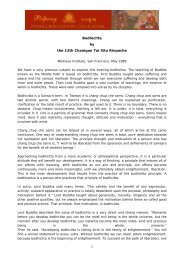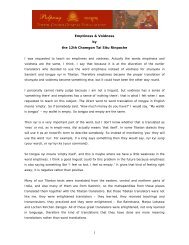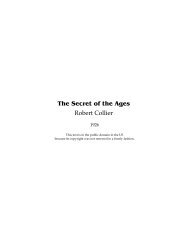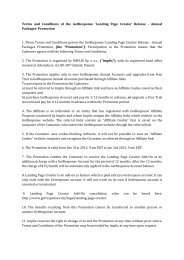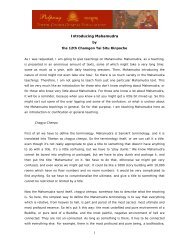1 The Essential Teachings of the Buddhadharma
1 The Essential Teachings of the Buddhadharma
1 The Essential Teachings of the Buddhadharma
- No tags were found...
Create successful ePaper yourself
Turn your PDF publications into a flip-book with our unique Google optimized e-Paper software.
All contents © Jamgon Kongtrul Labrang.For fur<strong>the</strong>r teachings visit:http://www.greatliberation.org/shopiiiiiiiv<strong>Buddhadharma</strong> is <strong>the</strong> Buddha’s teachings; dharma means “phenomena” or “mental objects” (cf. <strong>the</strong> tenetymological meanings <strong>of</strong> dharma in note 2).Interdependent origination (Tib. tendrel) has been translated as interdependence and dependentorigination. This is a very important concept since it explains how things happen without <strong>the</strong> existence <strong>of</strong>a god or creator. <strong>The</strong> Buddha explained simply that everything in <strong>the</strong> world is related to everything elseand when something happens it is due to <strong>the</strong> relationship between cause and effect. <strong>The</strong>re are actuallytwelve steps (called <strong>the</strong> Nidana chains): ignorance, mental formations, consciousness, name and form,<strong>the</strong> six sense fields, contact, feeling, craving, grasping, existence, birth, aging and death. Ignorance,craving and grasping are <strong>the</strong> afflictive mental states, mental formation and existence are karma, and <strong>the</strong>remaining seven are suffering. For a detailed explanation <strong>of</strong> this see Thrangu Rinpoche’s <strong>The</strong> TwelveLinks <strong>of</strong> Interdependent Origination, available from Zhyisil Chokyi Ghatsal Publications.<strong>The</strong> English term for this might be “transcendental compassion” meaning compassion not just for a fewpersons, but for all sentient beings. In <strong>the</strong> Sanskrit “bodhi” means “awakened” or “enlightened” and“citta” means “mind,” so bodhichitta means awakened mind. Many translators prefer “awakened” over“enlightened” because <strong>the</strong> word enlightened is a non-Buddhist term that was first used when Buddhismwas introduced. In Tibetan this “awakened mind” was translated as “chang chup kyi sem” in which“chang chup” means “awakened” and “kyi” is a conjunction and “sem” is mind. So <strong>the</strong> Tibetan translatorstranslated <strong>the</strong> Sanskrit quite literally into Tibetan<strong>The</strong> generation <strong>of</strong> bodhichitta is based on <strong>the</strong> altruistic wish to bring about <strong>the</strong> welfare, and ultimately<strong>the</strong> total liberation, <strong>of</strong> all sentient beings from all forms <strong>of</strong> suffering. What distinguishes bodhichitta from<strong>the</strong> ordinary compassionate aspirations to benefit o<strong>the</strong>rs shared by all people <strong>of</strong> good will is <strong>the</strong>recognition that one cannot ultimately fulfil <strong>the</strong>se aspirations until one has attained <strong>the</strong> state <strong>of</strong> mentalpurification and liberation <strong>of</strong> Buddhahood, which is <strong>the</strong> source <strong>of</strong> all positive qualities, including <strong>the</strong>omniscience that can see, individual by individual, <strong>the</strong> causes <strong>of</strong> suffering and <strong>the</strong> causes and path <strong>of</strong>liberation from suffering. This understanding gives rise at some point to <strong>the</strong> initial generation <strong>of</strong> <strong>the</strong>aspiration to attain <strong>the</strong> state <strong>of</strong> Buddhahood in order to liberate all sentient beings from suffering and toestablish <strong>the</strong>m all in states <strong>of</strong> happiness. This is called aspiration bodhichitta, which must be followed bywhat is called <strong>the</strong> bodhichitta <strong>of</strong> entering or application bodhichitta, which is <strong>the</strong> training in lovingkindness, compassion, <strong>the</strong> six paramitas or transcendent perfections, etc., which lead to <strong>the</strong> attainment<strong>of</strong> Buddhahood. Aspiration bodhichitta and application bodhichitta are both included in <strong>the</strong> term relativebodhichitta. Ultimate bodhichitta is direct insight into <strong>the</strong> ultimate nature. This state <strong>of</strong> primordialawareness is compassion and loving kindness and gives rise spontaneously and without preconception tocompassionate activity. – Lama Tashi NamgyalAll meditation can be divided into <strong>the</strong> two categories <strong>of</strong> tranquillity meditation (Shamatha) and insightmeditation (Vipashyana). Vipashyana in turn can be divided into <strong>the</strong> Vipashyana <strong>of</strong> <strong>the</strong> sutra traditionand <strong>the</strong> Vipashyana <strong>of</strong> <strong>the</strong> Mahamudra tradition. In <strong>the</strong> sutra tradition <strong>the</strong>re is analytical Vipashyana andplacement meditation. In <strong>the</strong> Mahamudra or tantric tradition, Vipashyana is based on <strong>the</strong> direct pointingout <strong>of</strong> <strong>the</strong> nature <strong>of</strong> mind and <strong>the</strong> nature <strong>of</strong> things by a fully qualified and experienced holder <strong>of</strong> <strong>the</strong>Mahamudra lineage.v <strong>The</strong> four extreme mental limitations are: believing things essentially exist, do not exist, both exist and donot exist, and nei<strong>the</strong>r exist nor do not exist. <strong>The</strong> eight mental constructs or complexities are mentalformulations that phenomena have such attributes as arising and ceasing, being singular or plural,coming and going, and being <strong>the</strong> same or being different.19



